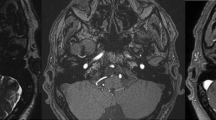Abstract
Vago-glossopharyngeal neuralgia (VGPN) is a rarely seen disease when compared to trigeminal neuralgia. When the pain is resistant to medical therapy, microvascular decompression can be performed if a vascular conflict is suspected on magnetic resonance imaging (MRI). In addition, arachnoid pathology may play a role in VGPN. We report two cases of VGPN caused by tethered arachnoid, associated with a vascular contact in which pain was reduced by freeing rootlets from arachnoid compression. We report two cases relating to 50-year-old and 30-year-old men with a history of electric shooting pain triggered by swallowing in the right pharyngeal and auricular regions. Preoperative MRI documented a neurovascular conflict in the first case and an arachnoid cyst in the second. Surgery was performed via a retrosigmoid craniotomy. In both cases, the intraoperative findings documented a tethered arachnoid membrane compressive to cranial nerves IX and X. Untethering was performed by liberation of the rootlets from the arachnoid with microvascular decompression. No additional rhizotomy was performed. The postoperative course was uneventful and pain was relieved in the first case and decreased in the second. In VGPN, a tethered arachnoid may play a role in causing the neuralgia, either alone or associated with a neuro-vascular conflict.


Similar content being viewed by others
References
Antherieu P, Vassal F, Sindou M (2016) Vagoglossopharyngeal neuralgia revealed through predominant digestive vagal manifestations. Case report and literature review. Neurochirurgie 62(3):174–177
Bonde V, Muzumdar D, Goel A (2008) Retroclival arachnoid cyst with hemifacial spasm. Singap Med J 49(10):e281–e282
Chen J, Sindou M (2015) Vago-glossopharyngeal neuralgia: a literature review of neurosurgical experience. Acta Neurochir 157(2):311–321 discussion 321
Fukuda H, Ishikawa M, Yamazoe N (2002) Glossopharyngeal neuralgia caused by adhesive arachnoid. Acta Neurochir 144(10):1057–1058 discussion 1058
Gosalakkal JA (2002) Intracranial arachnoid cysts in children: a review of pathogenesis, clinical features, and management. Pediatr Neurol 26(2):93–98
Higashi S, Yamashita J, Yamamoto Y, Izumi K (1992) Hemifacial spasm associated with a cerebellopontine angle arachnoid cyst in a young adult. Surg Neurol 37(4):289–292
Ishikawa M, Nishi S, Aoki T, Takase T, Wada E, Ohwaki H, Katsuki T, Fukuda H (2002) Operative findings in cases of trigeminal neuralgia without vascular compression: proposal of a different mechanism. J Clin Neurosci Off J Neurosurg Soc Australas 9(2):200–204
Mastronardi L, Taniguchi R, Caroli M, Crispo F, Ferrante L, Fukushima T (2009) Cerebellopontine angle arachnoid cyst: a case of hemifacial spasm caused by an organic lesion other than neurovascular compression: case report. Neurosurgery 65(6):E1205 discussion E1205
Ros López B, Martín Gallego Á, Iglesias Moroño S (2016) Arachnoid cysts of the central nervous system. Algorithms and recommendations for management. Neurocir Astur Spain 27(2):67–74
Sindou M, Howeidy T, Acevedo G (2002) Anatomical observations during microvascular decompression for idiopathic trigeminal neuralgia (with correlations between topography of pain and site of the neurovascular conflict). Prospective study in a series of 579 patients. Acta Neurochir 144(1):1–12 discussion 12-13
Takano S, Maruno T, Shirai S, Nose T (1998) Facial spasm and paroxysmal tinnitus associated with an arachnoid cyst of the cerebellopontine angle—case report. Neurol Med Chir (Tokyo) 38(2):100–103
Yang K-H, Na J-H, Kong D-S, Park K (2009) Combined hyperactive dysfunction syndrome of the cranial nerves. J Korean Neurosurg Soc 46(4):351–354
Author information
Authors and Affiliations
Corresponding author
Ethics declarations
Conflict of interest
The authors report no conflict of interest concerning the materials or methods used in this study or the findings specified in this paper. All patients have consented to submission of these case reports to the journal.
Rights and permissions
About this article
Cite this article
Bernard, F., Mercier, P. & Sindou, M. The tethered effect of the arachnoid in vago-glossopharyngeal neuralgia: a real associated alternative mechanism?. Acta Neurochir 160, 151–155 (2018). https://doi.org/10.1007/s00701-017-3369-8
Received:
Accepted:
Published:
Issue Date:
DOI: https://doi.org/10.1007/s00701-017-3369-8




